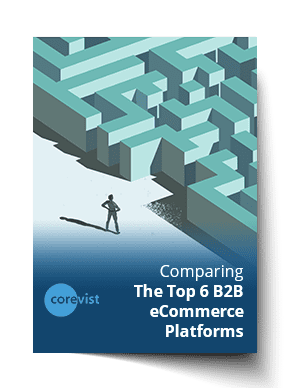Share
Author
George Anderson
Share
First published November 5, 2018. Updated Jul 5, 2022.
It’s no secret that B2B ecommerce can be difficult to sell across a large organization. One path forward is a simple B2B proof-of-concept (POC) without SAP integration. The idea is easy to grasp: Launch a good-looking, low-cost SaaS solution using a B2C-oriented platform. In so doing, you’ll prove to organizational stakeholders that ecommerce is viable.
This is a good option for companies that want to test their customers’ reaction to B2B eCommerce in a limited way. But a non-integrated proof of concept is limited. Here are 3 crucial things you should know, both for your proof of concept now, and for your permanent ecommerce solution.
1. A proof of concept proves… a concept, not a specific solution
A B2B eCommerce platform that’s easy to launch makes a good POC because the barrier to entry is low. With minimal risk, you can launch a SaaS solution with no integration to SAP, take a minimal number of orders, and input them manually into SAP. You’re not trying to prove the solution as a whole. You’re just proving that your customers will use B2B eCommerce.
That means that your chosen POC platform may not be the best permanent choice to support your B2B web channel. This is especially true if you use a solution like Shopify or Bigcommerce that doesn’t integrate to SAP out of the box. These platforms can prove the concept of eCommerce while not proving they are the right platform for your business.
In B2B scenarios, the key is often the depth of SAP integration required. Conventional platforms will struggle to provide the deep integration that manufacturers need. That’s why we recommend evaluating platforms from that perspective.
FREE Chart
Compare Top 6 B2B Platforms
Find your best fit based on revenue size, complexity, and depth of SAP integration required. Compare SAP Commerce Cloud, Salesforce B2B Commerce, and more.
2. Without integration, bad pricing & inventory data undermine customer experience
In the world of B2B eCommerce, everything starts with the user. What information do they need to make a confident decision to buy? Here’s the essential information for B2B purchases:
- Customer-specific catalogs and picklists (if your organization offers these)
- Accurate inventory availability (or personalized ATP, available to promise, if applicable)
- Accurate contract pricing (including quantity price breaks and bundled pricing)
- Requested delivery dates (if applicable)
- Choice of ship-from warehouse (if applicable)
- Choice of multiple sold-to accounts (if applicable)
Here’s why this data matters. Since your B2B eCommerce proof-of-concept isn’t integrated to SAP in real time, your customer will have all kinds of questions:
- Is the inventory still available, or has another order claimed it?
- Am I looking at list price, or my negotiated contract price?
- Why don’t I get the same quantity price breaks in B2B eCommerce that I get when I call customer service?
- I need the product ASAP—why can’t I choose the closest ship-from warehouse, like I can when I phone in my order?
- Where IS my last order? I need to check its shipping status, but the B2B eCommerce portal doesn’t show it.
- What’s my credit status? If I place a new order, is it going to go on credit block? I’d like to know so I can get invoices paid off (and thus ensure my order gets here on time).
Without deep SAP integration, a B2B eCommerce proof-of-concept can’t answer these questions. That can create a frustrating customer experience.
In a limited number of test cases (the B2B POC scope), this most likely won’t damage customer relationships. However, your permanent B2B eCommerce solution should take full account of SAP integration. (Hint: Corevist Commerce Cloud includes our comprehensive, prebuilt SAP integration. Learn more here: Our 49 SAP Integration Points.)
3. When moving forward from your B2B POC, consider SAP integration
Your B2B eCommerce POC most likely didn’t include integration to SAP. After all, why would it? You’re not testing whether integration will make things more efficient. You’re just testing your customers’ reaction to B2B eCommerce.
But as you move forward and evaluate permanent B2B eCommerce solutions, it’s crucial to consider SAP integration. B2B eCommerce orders have to get into SAP, and at scale, manual order entry gets expensive for you and time-consuming for your customer service staff.
Not only that, but a non-integrated permanent solution will generate order errors. These orders originate in 2 ways:
- Errors in CSR data entry—The order is properly formed and SAP-ready, but the CSR types it in wrong and SAP rejects it.
- Errors in customer order formation—The disconnected B2B eCommerce website allows customers to place badly-formed orders that SAP would never accept.
In the first case, CSRs can double-check against the original B2B eCommerce order and find the error they introduced. Not a big deal, but it will irritate them. At scale, it can create a lot of waste in your OTC (order-to-cash) cycle.
In the second case, CSR workload increases and the process becomes murky. The CSR has to reach out to the customer manually to figure out what they were trying to order. As a one-off case, this isn’t a huge problem, but at scale, it can also create waste in your OTC cycle.
Of course, CSR workload isn’t the only reason you need SAP integration. Your customers also need real-time SAP data to help them make buying decisions. Contract pricing, scaled pricing, inventory availability, ATP, ship-from warehouse, and many other data points really are required for customer confidence. Since that data lives in SAP, a real-time integration is most viable way to bring it to your customers through B2B eCommerce.
The takeaway: Don’t settle for a lack of integration
A non-integrated proof-of-concept is a great place to start in B2B eCommerce, especially if stakeholders within your organization are skeptical. However, it’s important to cover your SAP integration requirements when you choose your permanent B2B eCommerce solution. While integration may not be necessary in the POC phase, it can make or break your digital channel in the long run.
Want to become Easier To Do Business With?
Check out Corevist Commerce Cloud.
Managed B2B eCommerce with prebuilt integration for ECC and S/4HANA.











